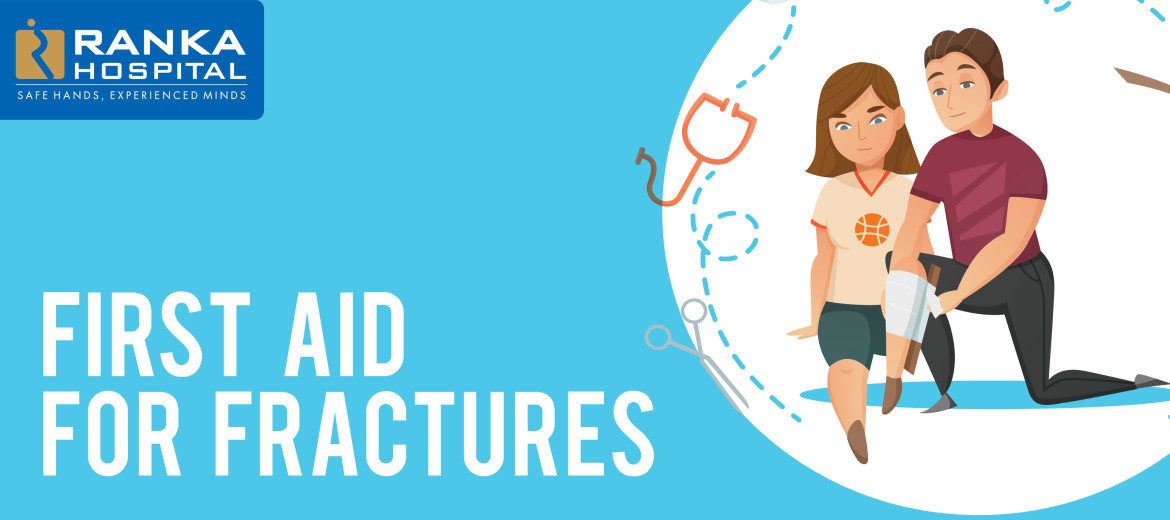First Aid Tips For Bone Fractures
Basic First Aid Tips For Bone Fractures
A bone fracture can occur anytime. You could be playing, driving or even walking. Though they are not life threatening, fractures can be extremely painful and require immediate medical attention to prevent permanent damage. We at Ranka Hospital will share a few basic first aid tips for fractures in this article.
Before we get to the actual first aid, when an injury occurs you need to be able to identify if it is actually a fracture. Here are some symptoms to look out for:
Signs and symptoms of a broken bone include:
• Intense pain at the injured area
• Visible deformity at the injured area
• Swelling & Bruising
• Bleeding (at times)
• Numbness
• Inability to put weight on the injured area
• Nausea and dizziness (at times)
If you aren’t sure if the injury is a fracture, treat it as if it is. Dislocations and sprains have the same method of treatment as does a fracture.
The first step of any first-aid is to stop the bleeding. If there is bleeding, use a clean cloth or gauze to apply pressure on the source of the bleeding. However if the bone is visible, don’t press on it. Take any clothing off the injured area.
In order to identify the fracture, don’t make the mistake of moving the injured part. This only makes the situation worse and may cause further damage. Movement may also provoke further shock. It is also not a very reliable method as often people are able to move the injured limb without much pain. It is best to try and leave the injured part in the position that it was found in and keep it immobilized.
To reduce swelling you can apply ice on the affected area. Ice is never directly applied to the skin. Place it in a cloth or a bag and then apply it. Adding a bit of water to the bag of ice will help the ice conform to the shape of the injury. Try elevating the injured area in order to reduce swelling. As far as possible, try not to move the person at all.
To immobilize the injured area, a method called splinting is used. A splint can be any long, firm object used to support and protect the fractured bone. They are similar to a cast but provide less support in comparison. While ready-made splints are available in the market, one may not have time or wherewithal to procure it during an emergency. For emergency situations, a make-shift splint can be made from basic household items such as cardboard, aluminum, sticks, rolled-up newspapers, or even a pillow. For an arm injury you can even pin the bottom of a shirt to the top and use it as a sling. Padding can be placed between the splint and the injured area. To secure the splint use broad materials like cloth or a belt.
A basic rule of splinting is to immobilize the joint above and below the broken bone without hampering circulation. For example, if the arm is broken from the middle, you will need to splint the wrist and elbow as well so as to avoid pressure from the movement of these joints. Dress the wound before applying a splint or sling.
To understand if the splint is too tight, compare the temperature of the affected area. For example the left and right arm can be compared. If the injured area feels cooler, the splint is hampering blood circulation. Differences in colour such as bluish-purple or paleness can also indicate a lack of circulation. One basic though not completely reliable method is to lightly squeeze the fingernails or toenails. When you do this, they become pale for a few seconds. On releasing them, the colour is supposed to return immediately. This method of checking circulation is called capillary refill.
While pressing the toes or fingers don’t let the person know which one it is. Ask them to tell you. If they can’t, it may indicate a lack of circulation or a larger problem.
Remember a splint is only used to prevent further damage, until the patient can be shown to a doctor.
If a rib has been fractured, the person may show difficulty breathing and may make a heavy wheezing sound. In such cases they should be advised to take shorter breaths. The intensity of a rib cage fracture depends on the number of ribs affected.
The patient may also be in shock. When shock occurs the body doesn’t get enough Oxygen to function properly. If the person seems to be suffering from shock make him/her lie down at an incline (with feet higher and head lower) and loosen any tight clothing. Keep the person warm and calm. While waiting for help to arrive, don’t let the patient eat or drink anything as they made need surgery soon.
Ranka Hospital is an emergency hospital in Pune, which has a 24*7 emergency care unit. If you find yourself in a situation involving a fracture, administer the above first aid and call us immediately.

